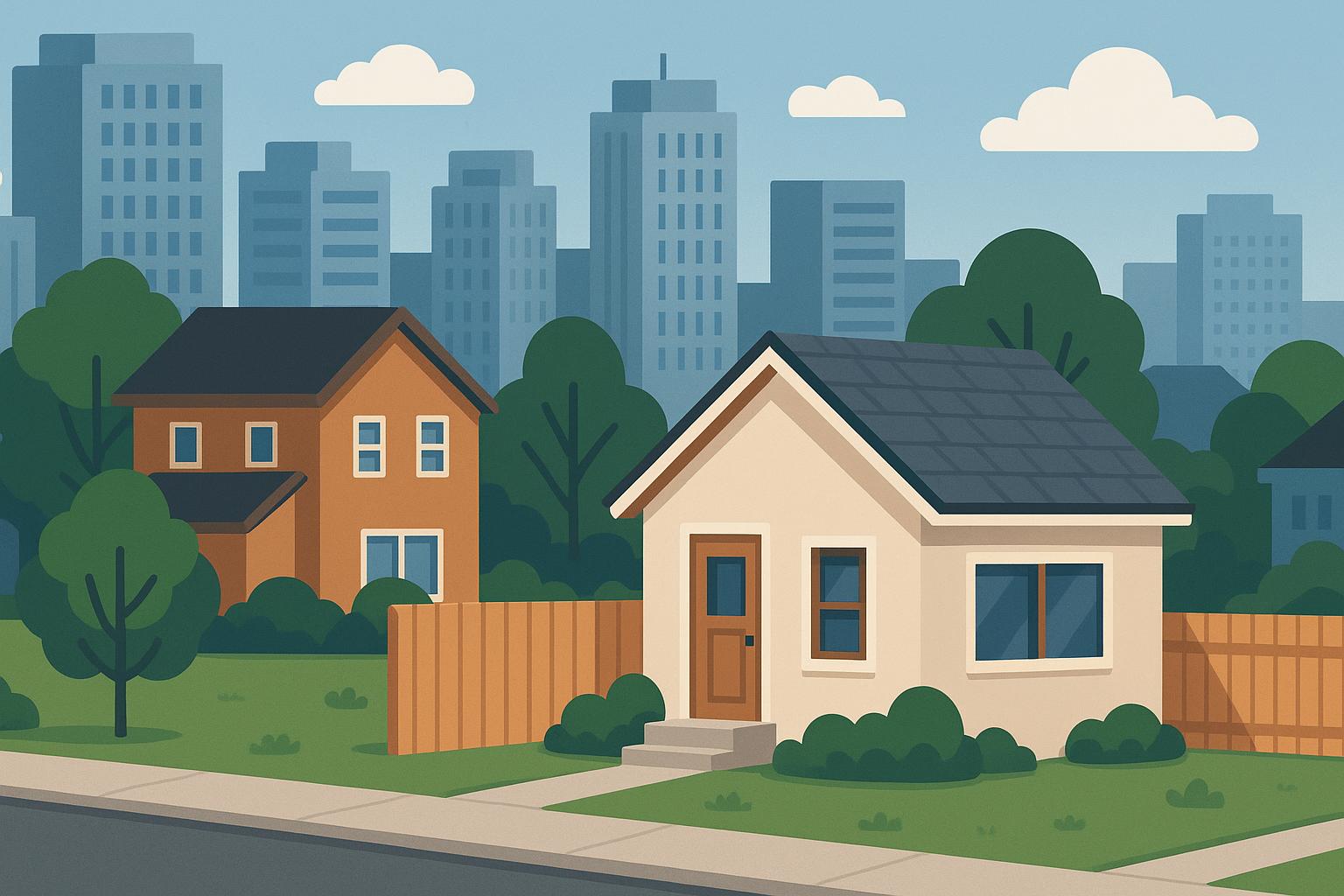
How a Density Bonus is Transforming Urban Planning and Backyard Homes in Canadian Cities
Estimated reading time: 8 minutes
Key Takeaways
- Density bonuses empower homeowners and developers to exceed standard zoning limits by delivering community benefits such as affordable housing or public amenities.
- ADU incentives encourage the creation of backyard homes, including laneway houses, garden suites, and coach houses, expanding affordable housing options.
- Canadian cities like Vancouver, Toronto, and Calgary are leveraging these tools for sustainable urban growth.
- Integration of density bonuses and ADU incentives helps maintain neighbourhood character while fostering smart growth and efficient land use.
- Homeowners can benefit from increased property values, new rental income opportunities, and flexible housing options.
Table of contents
Understanding Density Bonus: The Urban Planning Tool Changing Canadian Cities
What is a Density Bonus?
A density bonus is a planning tool that allows property owners or developers to exceed typical zoning restrictions. In exchange, they provide public benefits such as affordable housing units, parks, childcare facilities, or cash contributions. This win-win approach not only increases living space but also improves community infrastructure and amenities.
For more details, see how a density bonus works in North Vancouver and Mini Homes: The Ultimate Guide to Compact Living, Downsizing, and Urban Style.
How the Density Bonus Process Works
Municipalities typically follow these steps when applying a density bonus:
- Initial Application: A builder or homeowner applies to exceed regular zoning limits.
- Negotiation: The city and applicant discuss what public benefits—such as affordable housing or public spaces—will be delivered in exchange.
- Conditions: The project must meet specified requirements like providing in-kind amenities or making a cash payment.
Examples from Toronto include negotiating for park space or affordable housing, as detailed in Toronto’s density bonus process and Cash-in-lieu contributions explained.
Why Municipalities Use Density Bonuses
- Mitigating infrastructure impacts: Ensures that developments contribute to improvements such as road upgrades or parks.
- Aligning with community goals: Encourages growth that simultaneously meets public needs, including affordable housing and green spaces.
- Funding amenities: Provides a mechanism for delivering essential community services without raising taxes.
Learn more from Municipal Rationale for Density Bonus Programs.
ADU Incentives in Canadian Cities: Unlocking Backyard Homes
What is an ADU (Backyard Home)?
An Accessory Dwelling Unit (ADU)—often known as a backyard home—is a small, self-contained living space located on the same lot as a primary home. Examples include laneway houses, garden suites, coach houses, and basement or garage apartments.
For insights into ADU definitions and examples, visit Vancouver’s ADU zoning and density bonus incentives and explore Accessory Dwelling Units: The Ultimate Guide to ADUs for Canadian Property Investment.
Policy Trends: How Canadian Cities are Encouraging ADUs
In recent years, major cities have implemented policies designed to boost the creation of ADUs:
- Vancouver: Allows laneway houses and garden suites with relaxed restrictions.
- Edmonton: Revised zoning rules enable more garage and garden suites.
- Toronto: Expanded guidelines facilitate backyard home developments in key neighbourhoods.
These policies provide affordable rental options and optimize the use of underutilized residential land, as discussed in Vancouver’s approach to ADUs.
How Density Bonuses Integrate with ADU Incentives
Cities increasingly link density bonuses with ADU incentives to promote flexible housing development. Key features of this integration include:
- Extra Space: Homeowners can build larger or additional backyard homes by including affordable rental units.
- Relaxed Requirements: Some zoning restrictions like parking minimums or setbacks may be eased.
- Financial Assistance: Grants, fee waivers, or expedited permitting help reduce project costs.
Discover more about this integrated approach at North Vancouver’s combined density bonus and ADU approach and read about home office adaptations in ADU spaces through Home Office Solutions.
How Density Bonuses Encourage Backyard Homes in Canadian Cities
Direct Connection: Making Backyard Homes Possible
Density bonuses work by allowing homeowners to exceed zoning limits in exchange for community benefits. This flexibility paves the way for:
- Additional ADUs even on smaller lots
- Expanded structures for laneway or garden suites
- Flexible housing solutions for families and renters
- More efficient use of urban land
Benefits for Homeowners: More than Just Extra Space
Unlocking a density bonus not only enables the addition of a backyard home but also offers significant financial and lifestyle gains:
- Increased Property Value: A legal ADU or backyard home can boost property appraisal.
- New Rental Income: Renting out additional suites provides ongoing income.
- Flexible Housing Options: Ideal for multi-generational living or downsizing within the same property.
Learn from Vancouver’s backyard home density bonus results and see how increased density can drive property value and rental income in resources like Secondary Unit Benefits.
Canadian City Examples: Real-Life Strategies
Here are a few snapshots of how Canadian cities are applying these policies:
Vancouver
Vancouver leads with innovations such as laneway houses and garden suites, leveraging streamlined permitting and increased unit size in exchange for affordable rental contributions. See more at Vancouver Density Bonus and ADU Policies.
Toronto
Toronto’s negotiations tie density bonuses with affordable housing contributions, enabling multiple units on single lots. Details are available in Toronto’s Policy and Practice Overview and its Community Planning Report.
Calgary
Calgary’s Downtown Density Bonusing Offset Program rewards new projects—including ADUs—with zoning relaxations when public benefits are provided. More details can be found at Calgary’s Density Bonusing Offset Program.
Urban Planning Implications: The Bigger Picture
Advancing Affordable Housing and Smart Growth
The adoption of density bonuses and ADU incentives marks a shift in urban planning across Canadian cities. The key goals include:
- Affordable Housing: Promoting smaller, cost-effective homes to expand rental and ownership opportunities.
- Sustainable Neighbourhoods: Integrating new housing with public transit, walkability, and local businesses without heavy redevelopment.
- Smart Land Use Planning: Curbing urban sprawl by utilizing already-serviced land efficiently.
Read an in-depth analysis of these trends in Urban Planning and Sustainability in Canada and explore sustainable housing ideas with Tiny Home Living: Your Complete Guide.
Potential Challenges and Policy Criticisms
While density bonuses offer many benefits, challenges remain:
- Infrastructure Strain: Increased density may pressure local roads, sewers, and transit if upgrades lag.
- Neighbourhood Character: Concerns arise over changes to traditional residential aesthetics.
- Insufficient Contributions: Without adequate community benefits, residents may feel short-changed.
Further discussion on balancing these factors is available at Benefits and Challenges of Density Bonusing.
What Homeowners Need to Know: Navigating Density Bonus and ADU Incentives
Practical Advice for Engaged Homeowners
If you are considering adding a backyard home or applying for a density bonus, follow these steps:
- Consult your local planning department: They provide details about eligibility and program requirements.
- Monitor city websites: Stay updated on new announcements and policy revisions.
- Attend public consultations: Engage directly with city officials and planners.
- Prepare documentation: Gather site plans, proof of ownership, and other necessary details for your application.
- Seek professional advice: Consult with architects, planners, or housing consultants experienced in your local market.
Helpful resources include Vancouver’s step-by-step density bonus guide, North Vancouver’s tips for homeowners, and How to Choose a Reliable Tiny Home Builder in Canada.
Key Requirements for Backyard Homes with a Density Bonus
Certain criteria are commonly required when applying for a backyard home density bonus:
- Affordable Housing Units: Rent all or part of the ADU at below-market rates for a designated period.
- Cash-in-Lieu Contributions: Provide a financial contribution when in-kind amenities are not feasible.
- Design Guidelines: Ensure the ADU complies with local safety, setbacks, and environmental standards.
- Long-Term Agreements: Sign covenants to secure affordability or usage conditions over time.
For additional information, check out Municipal ADU guidelines and CNV’s requirements and best practices. If you’re planning to construct the unit yourself, consider this guide: How to Build a Secondary Suite Yourself.
Policy Changes to Monitor
Keep an eye on evolving policies that may impact eligibility and program details:
- Zoning Bylaw Adjustments: New rules may expand eligible properties for backyard homes.
- New Pilot Programs: Municipalities might launch initiatives to test innovative ADU incentives.
- Amendments in Amenity Contributions: Updates to required cash contributions or affordable housing obligations could occur.
- Official Community Plan Revisions: Large-scale policy shifts can trigger new opportunities for density bonuses.
Stay informed by regularly checking resources such as Calgary’s urban planning dashboard.
Conclusion: Backyard Homes and Density Bonuses are Shaping the Future of Canadian Cities
Density bonuses and ADU incentives have emerged as pivotal strategies in modern urban planning. They enable homeowners to add flexible backyard homes, increase property values, generate rental income, and contribute to alleviating the housing shortage while preserving community benefits.
In summary:
- Density bonuses allow extra construction with mandatory community benefits.
- ADU incentives facilitate the development of backyard homes, offering affordable and flexible living spaces.
- Together, these policies help cities grow smartly, maintain neighbourhood character, and address the housing needs of Canadians.
Homeowners are encouraged to remain engaged with local planning processes, attend consultations, and continually monitor policy updates to make the most of these evolving opportunities.
For further reading and policy updates, explore resources such as Toronto density bonus policies, North Vancouver development incentives, and Vancouver’s ADU and density bonus zoning.
Frequently Asked Questions
What is a density bonus?
A density bonus is a planning mechanism that enables property owners and developers to surpass standard zoning limits by agreeing to provide public benefits, such as affordable housing units, parks, or community amenities.
How do ADU incentives work?
ADU incentives encourage the construction of accessory dwelling units (backyard homes) by relaxing zoning restrictions and, in some cases, offering financial or permitting assistance. These measures help expand rental options and improve property flexibility.
Which Canadian cities are leading in these initiatives?
Cities like Vancouver, Toronto, and Calgary are at the forefront, each implementing its own version of density bonus and ADU incentive programs.
What are the benefits for homeowners?
Homeowners can benefit from increased property value, additional rental income, and greater flexibility in housing options, all while contributing to their community through enhanced public amenities.
How can I learn more about applying for these programs?
It is best to consult your local planning department, review the city’s official website, and consider professional consultation to navigate the application process effectively.

Leave a Reply